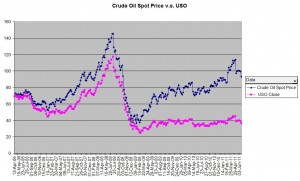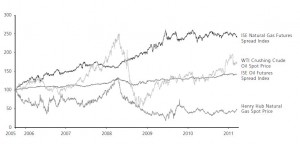In the past, I have been an active investor in oil via the USO ETF, but I stepped aside because of USO’s poor performance in tracking the spot price of oil. The reason for the poor performance was not a mystery—oil futures have been in steep contango, with the front-month price lower than subsequent delivery dates. When USO rolls their contracts into longer-dated contracts they have to sell cheap and buy dear. The graph below shows the ugly result.

.
.
.
.
.
.
.
.
UBS just introduced two ETNs that are designed to profit from persistent contango in oil (ETRACS Oil Futures Contango: OILZ) and gas (Natural Gas Futures Contango: GASZ)—by shorting the front month and going long on longer-dated futures. Their backtesting on crude oil futures over the last 5 1/2 years shows an average annual return of 6.58%, compared to 10.2% for crude oil, but with a lot less volatility. In the OILZ prospectus, they include the following backtest results.

.
.
.
.
.
.
..
.
The natural gas results are even better, with an annualized growth of 17.58% compared to an overall drop of 12.8% in natural gas prices.
What are the risks? The two that come to mind are: the contango term structure goes away, and the price of these commodities dropping across the board. Some comments about contango:
- Contango is normal on commodities that have a significant cost-to-carry. A barrel of oil takes up a fair amount of space, so storing it for a further out delivery date will cost more.
- Some commodity ETFs avoid the problems with contango by physically storing the commodity themselves (e.g., Gold with GLD, and silver with SLV). That way they can avoid the futures markets and the requirement to roll futures over time. This is not practical for crude oil.
- Short term shortages can boost short term prices. If the shortage is perceived to be short-lived the longer term contracts might not go up much
- I haven’t investigated this, but some people claim the contango should only reflect carrying costs and that if it is higher it is due to speculation by hedge funds and other bad characters. I wouldn’t be surprised if the dramatic rise in participation in commodities investment by people that have no intention of taking delivery has increased contango—reflecting the greater price uncertainty there is on longer-term contracts.
- These funds are pretty insensitive to the price of the commodities because they combine both a long and a short position. The backtesting shows that the severe oil and natural gas crashes of 2008 did not have much of an effect.
Because these funds have a short component, they have the potential to drop below zero if there wasn’t some sort of circuit breaker arrangement. The fund value will never drop below zero, but the funds may be “accelerated” (terminated) if they drop in value below $5/share (they are currently at $25), or if they drop 60% or more from the previous day’s indicated value. Because these funds both have a long component also I think this scenario is highly unlikely.
Overall I think these two funds are intriguing. Betting on contango seems reasonable to me.
.


Click here to leave a comment